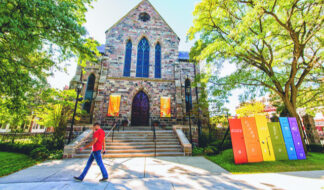Bloomfield Hills –
From the sweeping concrete vaults of the TWA Terminal at JFK Airport in New York to the 630-foot-tall Gateway Arch in St. Louis, the iconic designs of Eero Saarinen (1910-1961) captured the aspirations and values of mid-20th-century America.
Potent expressions of national power, these and other Saarinen-designed structures — including the General Motors Technical Center in Warren, Mich.; Dulles International Airport Terminal outside Washington, D.C.; and the corporate headquarters of John Deere in Illinois and CBS in New York — helped create the international image of the United States in the decades following World War II.
Cranbrook Art Museum is proud to present the North American premiere of the first major retrospective ever mounted on the career of Eero Saarinen. "Eero Saarinen: Shaping the Future," runs through March 30, featuring work that Eero completed at Cranbrook as well as an extensive collection of furniture, photographs, drawings and models representing his entire career.
A native of Finland, Eero Saarinen arrived at Cranbrook with his parents — the renowned sculptor and weaver Loja Saarinen and architect and educator Eliel Saarinen — and his sister designer Pipsan Saarinen Swanson in 1925 at the age of 15. Cranbrook profoundly shaped his life and work.
Between 1928-1931, the young Eero was offered opportunities to create decorative pieces for many of the campus buildings including furniture for Saarinen House, the family home, as well as chairs, tables, sofas, beds and lamps for Cranbrook's Kingswood School for Girls on the 300-acre campus. At Cranbrook, Eero Saarinen eventually came to know and work with Florence Knoll Bassett, Charles and Ray Eames, Harry Bertoia, Ralph Rapson and many other faculty and students who heralded a golden epoch in Cranbrook Academy of Art's history.
In his later career, Eero nurtured some of the best young talents from around the world, many of whom went on to have significant practices of their own including Cesar Pelli, Robert Venturi, Ralph Rapson and others. Working together with these young men – in a surprisingly modest office just north of the Cranbrook Campus in Bloomfield Hills, Mich. – Eero Saarinen produced a series of masterpieces of breathtaking individuality for which he is best known including: the General Motors Tech Center, "a Versailles of Industry," (1948-56) in the suburbs of Detroit; the 630-foot-tall, stainless steel St. Louis Gateway Arch (1948-64) along the Mississippi River, commemorating America's westward expansion; and the TWA Terminal (1956-62) at New York's John F. Kennedy Airport, where swooping concrete vaults thrilled travelers with the new glamour of worldwide flight.
Deploying progressive construction techniques and a highly personal, exuberant, and often metaphorical aesthetic, Saarinen's work defied Modernist orthodoxies and gave iconic form to the postwar American ideal of an open-ended society of unbounded choice and diversity – an ideal that persists to this day. In his search for a richer and more varied modern architecture, Saarinen became one of the most prolific and controversial practitioners of his time, and one of the most influential.
Among highlights of the exhibition, "Eero Saarinen: Shaping the Future," are never-before-seen sketches, working drawings, models, photographs, furnishings, films and other ephemera from Cranbrook's Art Museum and Archives as well as various national archives and private collections.
Topics:
Entertainment









